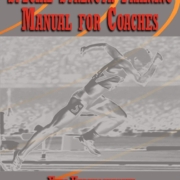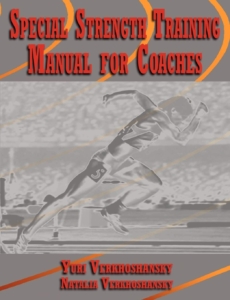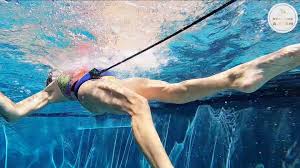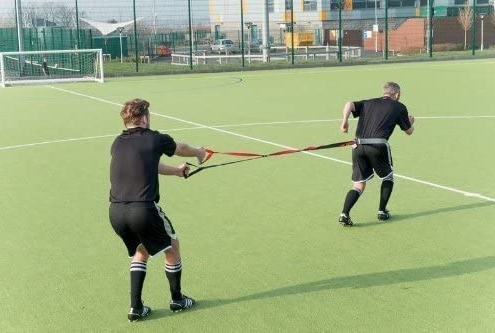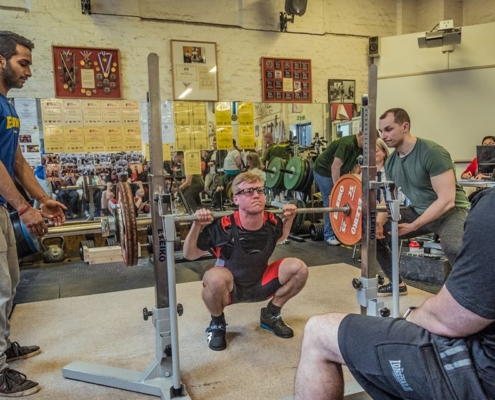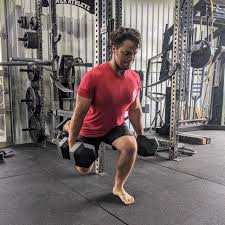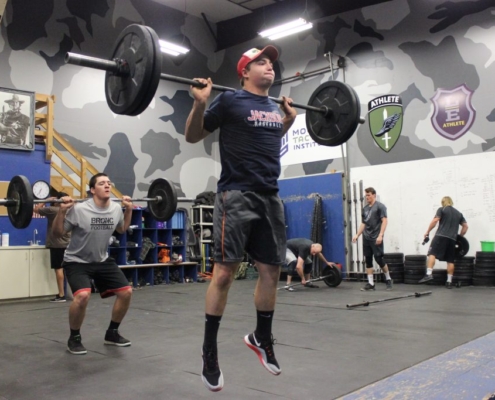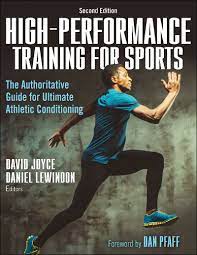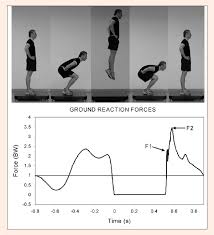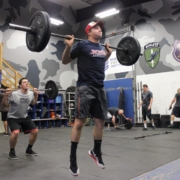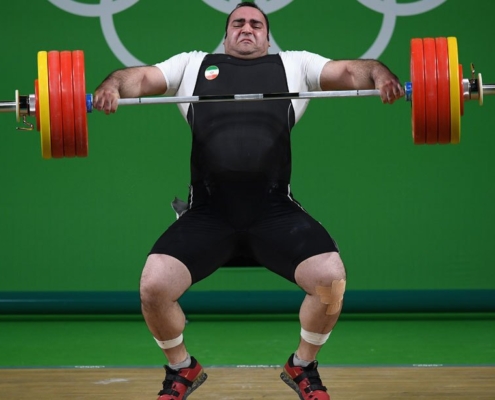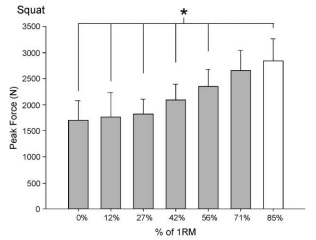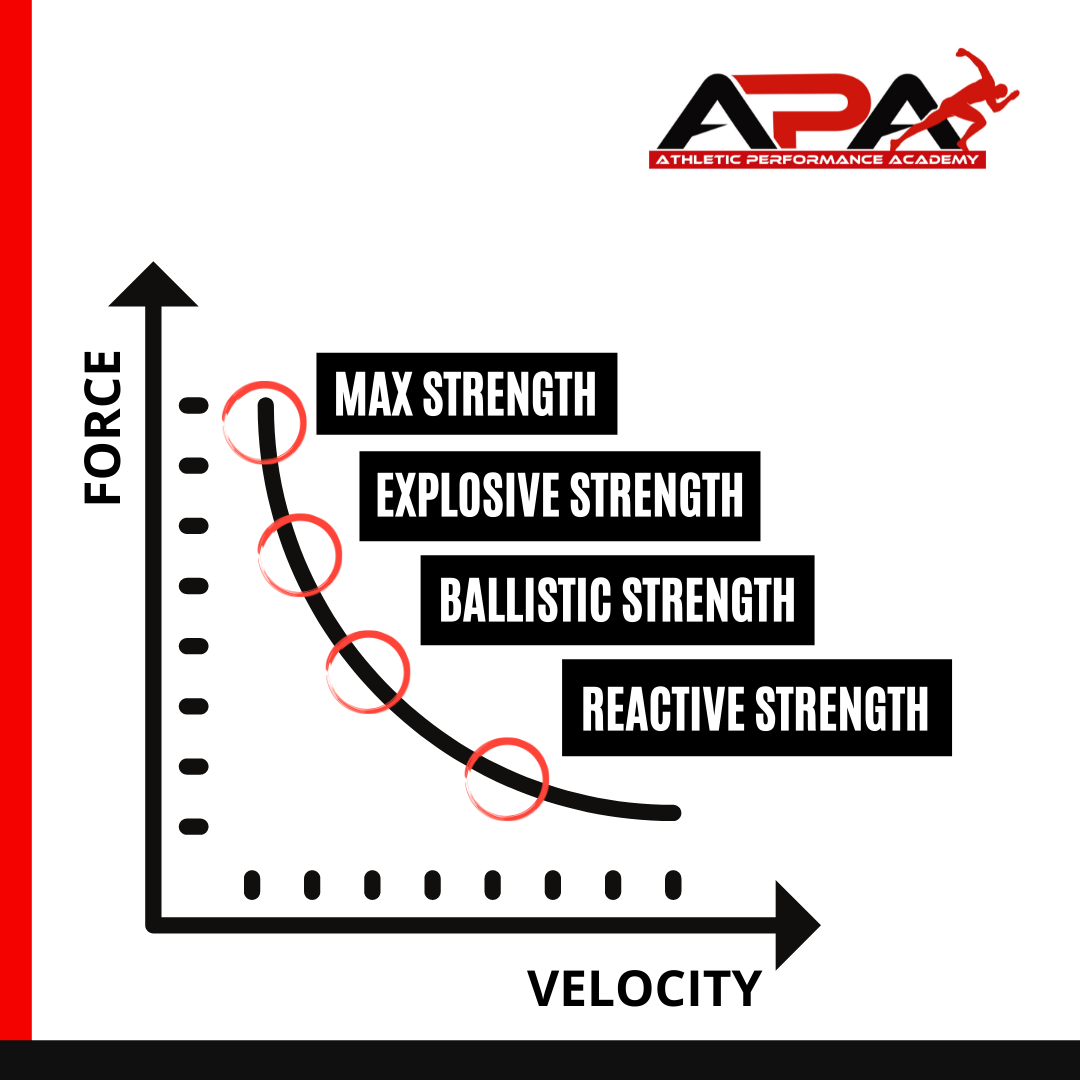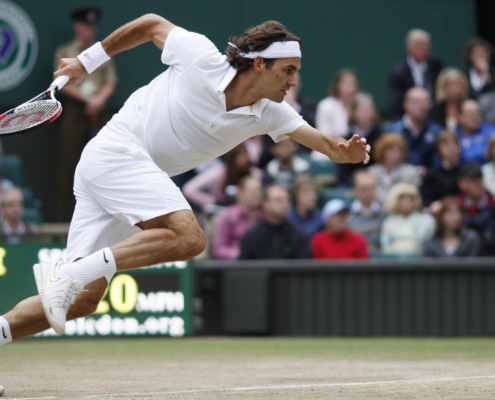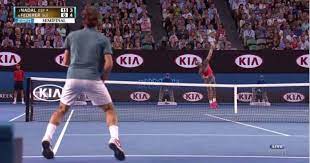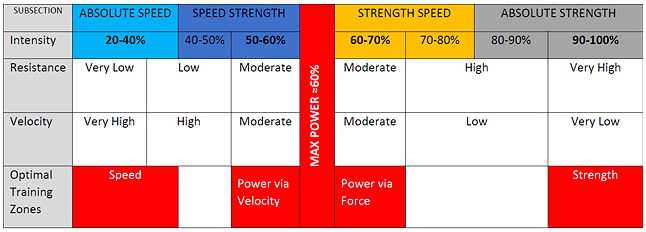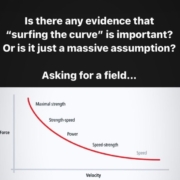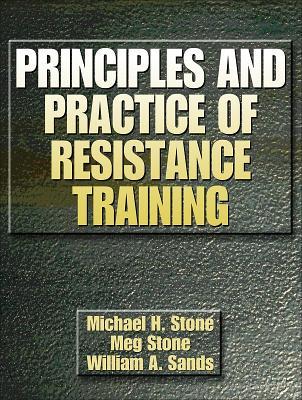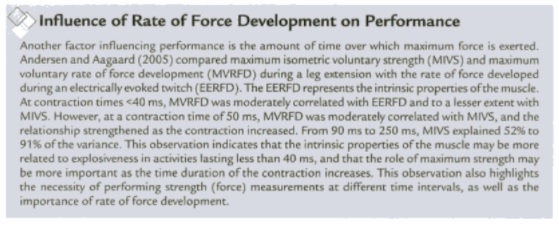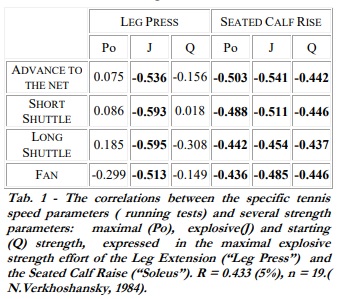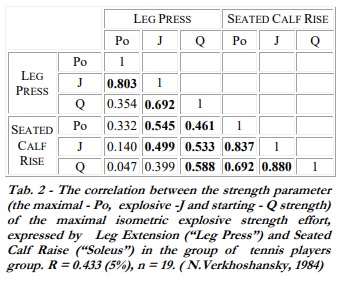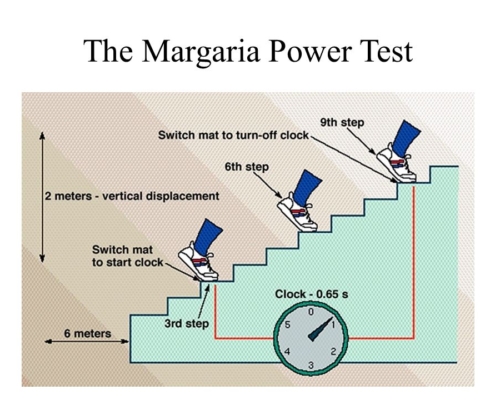In my last blog I talked about conceptualising the forces acting on the body by using the F-V curve and placing various tennis actions on the curve. I ask my coaches to do this exercise when they first work in Tennis with APA and so in Part 2 of this blog I will present an example from one of my coaches.

Before we get to the F-V curve in Part 2 I wanted to comment on an instagram post that @jump.science has wrote:
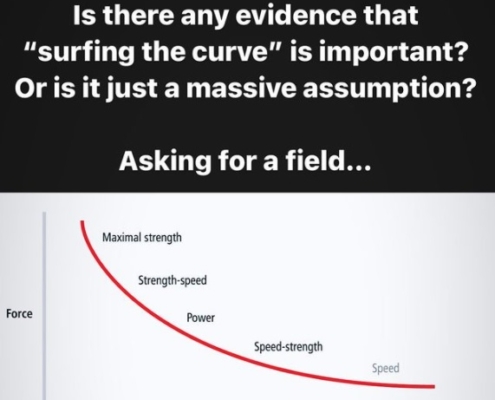
For reference in the blog I will refer to the following by number – Maximal strength (1), Strength-speed (2), Power (3), Speed-strength (4), and Speed (5).
First of all I’d like to give a definition for all these terms in case you missed my Force-Velocity Curve for Tennis – Part 1
Strength
Maximal strength (1) – Maximum voluntary strength is the maximum amount of strength that can be produced voluntarily without electrical augmentation. For the purposes of simplicity I will refer to this as ‘Maximum strength’ and practically speaking this is usually obtained in a laboratory as peak force during a single joint movement and isolated muscle.
Just to give you some indications of peak force, I’ve pulled some numbers from a research study- Cormie et al (2007) – Optimal loading for Maximal Power Output during Lower-Body Resistance Exercises.
Peak Force- Isometric squat 4250 N; Isometric Mid-thigh Pull (IMTP) – 3900 N; 1RM Back squat (BS)- around 3000 N. Peak force on 90% Power clean is about the same as an 85% BS- around 2750 N
What’s worth noting is that at 60% 1RM on BS you already hit about 80% of 1RM peak force. This means you can work in a sweet spot of 60% 1RM which is the load that optimises maximal power for the BS but also achieves a high percentage of peak force.
Rate of Force Development
Rate of Force Development (RFD) = is the change in force divided by change in time and is directly related to the rate of increase in muscle activation by the nervous system. Although force is directly responsible for the acceleration of an object, one may argue that the faster a given force is attained, the more rapid the corresponding acceleration of a mass. Thus, RFD can be associated with the ability to accelerate objects. Therefore, attaining a high average or peak RFD (explosive strength) is associated with high acceleration capabilities.
Explosive strength (2) = the peak RFD has been termed explosive strength (PRFD), or stated another way it’s the athlete’s capacity to achieve the peak force in the shortest time. Some coaches refer to this as ‘strength-speed.’ This has lead to a range of training methods which utilise moderate to heavy loads (e.g., 80-90% 1RM for Olympic lifts).
Starting strength (4) = the force generated in the first 30 ms has been termed starting strength and is related to the initial rate of force development. Some coaches refer to this as high speed-strength (e.g., Verkhoshansky). This has lead to a range of training methods which utilise moderate to lighter loads (30-60% 1RM) and Slow SSC plyometrics (more on this later).

Speed (5) = speed is a scalar quantity and is the magnitude component for the vector termed velocity. Velocity has both a magnitude (speed) and a direction. Velocity = distance / time. This has lead to a range of training methods which utilise light loads (<30% 1RM) and sprinting and Fast SSC plyometrics (more on this later).
Power (3) = work is an expression of force acting on an object through a DISTANCE and is independent of time or velocity. In simple terms, a strength measurement of external CONCENTRIC work can be measured using the weight of the bar and the vertical displacement. Power is essentially a ”work rate,” and can be described by the equation:
P = W / T, since Work = Force x distance –> P = F x d / t but since Velocity = d /t
P = F x V
Or if you rearrange the equation differently, (F/t x d) = RFD x d
When in contact with the ground, the athlete generates power by developing high levels of force in short duration (RFD) and displacing his/her center of mass through an appropriate range.
For any given athlete performing a dynamic movement where the center of mass is being displaced, these terms may be used interchangeably. However, in isometric contractions where there is no displacement then there will be high levels of RFD but zero power.
This is worth bearing in mind when considering different types of muscle contraction and various training modalities with respect to force application and movement velocity.
What’s his point?
Jump.science is calling into question the middle of the curve.
”If I’m training for speed/jumping I should definitely sprint and jump. These are already the ultimate explosive training stimulus. Compared to these, exercises like loaded jumps and Olympic lifts are relatively slow with long time frames for force production. Thus they have no explosive benefits to offer. They can only serve as strength training.
Now historically I myself have used explosive lifting to contribute to overall STRENGTH training volume, and I do not intend to criticise that practice, but obviously heavier lifting is more influential on strength.
So if we skip cleans and just deadlift or skip loaded jumps and just squat, do we sacrifice much of anything? Do we need to break our lifting into 4 categories and make sure we hit each one? I would argue No.”
So, what he is saying is just skip (2), (3) and (4). To be fair, from looking at the comments and his reply, he seems to point the finger more at speed-strength (4), especially if you are talking about squatting with less than 30% 1RM as speed-strength.
What does the Research Say?
In my previous blog I made the point that for untrained athletes Maximum Strength has the effect of developing peak force and also peak RFD at the same time. So initially I’d agree to focus on that (the F end of the F-V curve).
Therefore, once someone has squeezed the juice out of Max strength training we need to look at further ways to get more explosive (increase RFD).

Training at the Optimal Load
One approach to improve power/RFD is to train at the intensity that optimises power output for that movement. Let’s look at three classic movements- the squat (S), jump squat (JS) and power clean (PC).
The Geeky Science on Power Output– Cormie et al (2007) – Optimal loading for Maximal Power Output during Lower-Body Resistance Exercises
The JS, similar in nature to the bench throw, is considered a ‘’ballistic’’ exercise in that the deceleration phase is much smaller in comparison with the standard squat movement, where the bar is not released or thrown.
Peak power typically occurs just before take-off. The optimal load for the JS was 0% of 1RM- 6437 W. Peak velocity 3.66 m/s
The 0% 1RM load was light enough for athletes to generate very high velocities (peak velocity: 3.66 m/s) and the body mass provided enough resistance to produce substantial force output (peak force 1990 N). Therefore, this load permitted the most favourable combination of force and velocity.
Peak Power in the BS was maximised at 56% 1RM-3250 W; however, power was not significantly different across the loading spectrum. Peak velocity 1.5 m/s
It is speculated that the deceleration phase of the PC would fall somewhere between the JS and S. The optimal load in the PC occurred at 80% 1RM- 4786 W. Peak velocity 2.0 m/s (this also corresponds with the peak velocity of a 20% 1RM BS).
The mid-thigh pull is a modified version of the hang PC, without the catch that involves the segment of the PC, in which peak power typically occurs (i.e., during the second pull phase before the catch phase).
If you think about the vertical velocities in the gym and how they compare to athletic movements such as the jumping events in track & field we have velocities at optimal loading for peak power of 1.5, 2.0 and 3.66 m/s for the BS, PC and JS, respectively. This compares to 2-5 m/s for the jumping events.
Beyond the Force Velocity Curve with Assisted Jumps Training
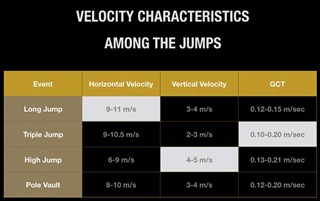
I definitely think it is important to train at around 80% for PC and 60% 1RM for BS as it’s the load that maximises power output in these lifts. These loads correspond with loads recommended in classic protocols used to target RFD (explosive and starting strength) through Max Load Method and Max velocity Method, respectively (see below).
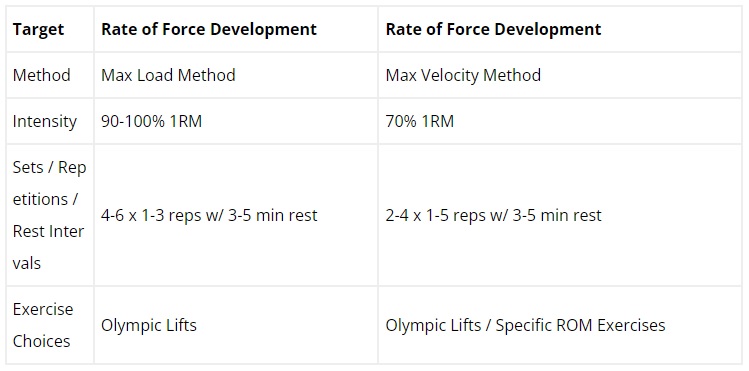
It just so happens that these loads correspond to the ‘optimal’ load for developing peak power in the back squat and Olympic lifts, respectively.
 Daz comment: However, I’d like to state that just because I think it is important to train at these loads to develop explosive strength I am not suggesting to train exclusively at the load that optimises power output for a particular exercise. For example, with the BS I would favour training at intensities above and below 60% 1RM, and place particular emphasis on training above 60% 1RM to develop maximum strength.
Daz comment: However, I’d like to state that just because I think it is important to train at these loads to develop explosive strength I am not suggesting to train exclusively at the load that optimises power output for a particular exercise. For example, with the BS I would favour training at intensities above and below 60% 1RM, and place particular emphasis on training above 60% 1RM to develop maximum strength.
A Word on Olympic Weightlifting
Similar to ballistic exercises (which we will come on to next!), weightlifting exercises require athletes to accelerate throughout the entire propulsive phase or second pull, causing the projection of the barbell and often the body in the air.
However, they differ from ballistic exercises in that they require the athlete to actively decelerate their body mass in order to catch the barbell. As we have just seen, the inherent high force, high velocity nature of weightlifting exercises creates the potential for these exercises to produce large power outputs across a variety of loading conditions. They significantly improve not only maximal power output but, more specifically, power output against heavy loads. Thus, the use of these movements in training is ideal for athletes who are required to generate high velocities against heavy loads including wrestlers, rugby union front rowers and American football linemen.
The Geeky Science on Olympic Lifts- Garhammer et al (1993)
Analysis of the Clean- The total average power of the athlete while lifting the barbell from the floor to maximum vertical velocity position was 4191 W, equaling 33.5 W/kg. Corresponding value for elite women is 21.8 W/kg. The weight lifted in a snatch is about 80% of that lifted in a clean but total average power output values, however, tend to be very similar- [presumably due to a greater average and peak velocity during the pulling motion].
In weightlifting it is of value to determine the power output during the second pull for snatch and clean lifts. This is a very high-power phase of the pull for a clean or snatch lift and relates well biomechanically to the jerk lift and to vertical jumping.
Second pulls begin after the bar has cleared knee height and the lifter has shifted his or her hips forward to keep the bar as close to the body as possible. Second pulls are of very short duration, typically between 0.10 and 0.20 seconds.
The average power output of the athlete during a second pull was 6981 W equaling 55.8 W/kg.
Compare these to average power outputs for squats/deadlifts (12.7 W/kg) and bench press (4.6 W/kg).
A typical maximum vertical velocity during a clean or snatch pull would be 1.6 m/s and 2.0 m/s respectively, while for a deadlift it would be about 0.6 m/s. Consider that a deadlift takes 2.0 s from lift-off until finish and the barbell is elevated 0.6 m. The main reason that the deadlift power output is about one-third of the clean pull is that the deadlift (2.0 s) lasts about three times as long as the clean pull (0.72 s)
Because Olympic lifts are so fast for such a large amount of load lifted, the average power and peak power outputs are similar. But peak power during a lifting movement is higher. The average power output values are average values over time intervals ranging from 0.1 s to 0.8 s.
Garhammer calculated ‘instantaneous’ power outputs for 0.02 s intervals and found values higher than 60 W/kg, which were found for some male weightlifters during entire second pulls and jerk thrusts. If film analyses were conducted at 0.01 s intervals ‘’instantaneous values of 70-80 W/kg would be likely. This is comparable to instantaneous power output values of 60 to 75 W/kg reported for vertical jumps.
But even though the optimal load in the PC occurred at 80% 1RM which is a common load used in training of Olifts are don’t just train at the optimal load for maximal power output!
The use of the optimal load for power development results in a muted ability to improve strength levels which can have significant ramifications when working with athletes who must express high power outputs under loaded conditions. (especially if you are mainly doing unloaded JS!) Furthermore, training at the optimal load has the inherent limitation of only maximising power output at or near the load that is being trained.
Wrap up on Explosive Strength
Although some coaches have questioned the merits of training exclusively at the optimal load, there can be no doubt that there is a place for performing exercises which require higher levels of external opposition. The optimal load – the load that maximises peak power – is 60% 1RM for back squat and 80% 1RM for the power clean- loads that can be considered suitable for developing ”explosive strength.”
”In achieving the maximum speed of explosive movements, the relevance of maximal strength depends on the level of the external opposition to be overcome: the higher the external opposition, the higher the level of Maximal Strength necessary to ensure the maximal speed of movement.” pg 43, Special Strength Training Manual for Coaches (Verkhoshansky, 2011).
Loaded conditions may involve activities such as a collision in contact sports such as American football, rugby and wrestling
OR
An athlete changing direction where they must apply even greater forces to change the momentum of the system (mass x velocity). This last point is important because it would be incorrect to assume that the only athletes who need explosive strength are those that have to work against another human being.
Tennis example- recall that max strength helps improve our force generating abilities – when movement velocity is zero, which is the case during the very initial movement after being ‘wrong footed.’ In the example below, Rafa Nadal has expected to move to his left and has been wrong footed, so he needs to stop his motion and then sprint off in the opposite direction from a stationary position. Maximal Strength and the Explosive Strength, expressed in isometric regime will be a key physical quality
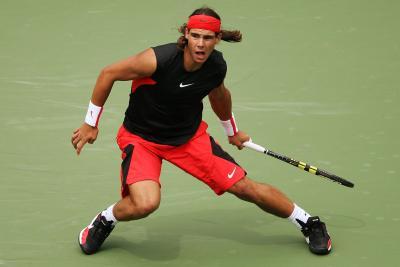
So, the question one always has to ask oneself is, what is the level of opposition to be overcome in your sport? Now by ‘opposition’ I don’t just mean your opponent (as in American Football, Rugby or Wrestling). Your own inertia is something that needs to be opposed and overcome, and from a static start it requires Maximal Strength and Explosive strength from an isometric position to initiate movement.
In a lot of sports movements however, we need to overcome a lower level of opposition- Acceleration phase of tennis serve and ground strokes and most tennis movements within a few metres comes to mind. This is where ballistic method comes into play.
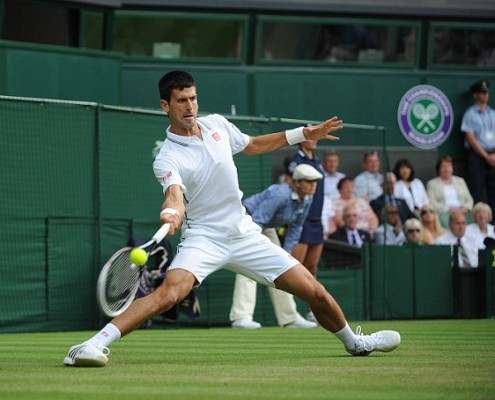
Training for RFD- Ballistic Method
Ballistic exercises including the jump squat and bench throw circumvent any deceleration phase by requiring athletes to accelerate throughout the entire range of motion to the point of projection (i.e., take off or release).
Typically these exercises are performed across a variety of loading conditions from 10-50% of the 1RM to enable selective recruitment of fast twist muscles fibers and enhanced muscular firing rates. Exercises including weighted jumps, Olympic weightlifting movements, and implement throwing (such as medicine balls) are excellent methods of developing specific strength with a velocity focus.

This is the category of strength training that @jump.science feels is most pointless. For completeness, at APA we use 30-60% 1RM for the Jump squat as a go to loading scheme for Ballistic strength. Full disclosure; the science below doesn’t make a clear case for doing lightly loaded jumps in favour of say plyometrics, so I’ll be coming back to this specific comment from @jump.science in a follow up blog as I don’t want to dodge the question. But for now let’s look at the overall benefits of ballistic strength training.
What does the Research Say?
Previous literature has shown significant performance improvements after jump squat training with 30% 1RM (McBride et al, 2002; Wilson et al, 1993) featured in Cormie et al (2010).
The reader is also directed to an excellent review paper by Cormie et al (2011)- Developing Maximal Neuromuscular Power- Part 2
‘’The use of light loading conditions equivalent to 0-60% of 1RM in conjunction with plyometrics permits individuals to train at velocities similar to those encountered in actual on-field movements.
Furthermore, light loads are recommended due to the high RFD requirements and the high power outputs associated with such resistances. Therefore, ballistics with light load and/or plyometrics are recommended for athletes who are required to generate high power outputs during fast movements against low external loads such as in sprinting, jumping, throwing and striking tasks.
It is important to note, however, that these findings are only relevant when light loads are utilised with ballistic and plyometric exercise. The use of light loads with traditional resistance training exercises is not recommend because such training would not provide an adequate stimulus for adaptation in either force or velocity requirements of such exercises.”
Cormie et al (2010)- Adaptations in Athletic Performance after Ballistic Power versus Strength Training
Usually ballistics and plyometrics get heaped in one category so it’s difficult to separate their effects. However, this was one such study that at least had a strength training only and a power training only group, which lifted no more than 30% 1RM, so you can at least delineate high load from low load derived adaptations.
The strength training group followed a programme involving the back squat exclusively. Session 1 – 3×3 at 90% 1RM; Session 2- 3×6 at 75% 1RM and Session 3- 3×4 at 80% 1RM.
The power training only group did two sessions per week using body mass jump squats (7 sets x6 reps) and one session per week where they performed 5 sets x 5 reps of maximal effort jump squats with 30% 1RM.
It’s a pity they didn’t have a design with three groups- one that did strength, one that did 30% loaded jumps and one that did unloaded jumps.
Anyway, in the group of ‘’relatively weak men’’ in the study (1RM around 1.3 x body mass), both experimental groups showed significant improvements in jump and sprint performance with no significant between group differences in either jump (peak power: ST = 17.7%, PT = 17.6%, around 10 W/kg) or sprint performance (40-m sprint: ST = 2.2%, PT 3.6%). ST also displayed a significant increase in maximal strength that was significantly greater than the PT group (squat 1RM: ST = 31.2%, PT = 4.5%).
It was concluded that the ability of strength training to render similar short-term improvements in athletic performance as ballistic power training, coupled with the potential long-term benefits of improved maximal strength, makes strength training a more effective training modality for relatively weak individuals.
It is worth pointing out that the power group significantly increased the rate of rise in EMG of the vastus medialus during the 0% 1RM JS test and RFD during isometric squat test. This was associated with slight modifications in jump mechanics (i.e., a marginally shorter but faster countermovement) and a significant decrease in time to take off specific to ballistic power training with jump squats.
A word on Plyometrics
Just so we are clear, plyometrics are ballistic in nature, but they are delineated from specific ballistic exercises within the APA method due to the way these exercises are overloaded. Typically, they are performed with little to no external resistance, such as with body mass only or light medicine ball, and overload is applied by increasing the stretch rate by minimising the duration of the SSC and/or stretch load by, for example, increasing the height of the drop during drop jumps.
Plyometrics can be tailored to train either short SSC movements characterised by a 100-250 ms duration (i.e., ground contact in sprinting, long or high jump), or long SSC movements characterised by duration greater than 250 ms (i.e., countermovement jump [CMJ] or throw).
I hope you found this article useful.
Remember:
- If you’re not subscribed yet, click here to get free email updates, so we can stay in touch.
- Share this post using the buttons on the top and bottom of the post. As one of this blog’s first readers, I’m not just hoping you’ll tell your friends about it. I’m counting on it.
- Leave a comment, telling me where you’re struggling and how I can help
Since you’re here…
…we have a small favor to ask. APA aim to bring you compelling content from the world of sports science and coaching. We are devoted to making athletes fitter, faster and stronger so they can excel in sport. Please take a moment to share the articles on social media, engage the authors with questions and comments below, and link to articles when appropriate if you have a blog or participate on forums of related topics. — APA TEAM
=> Follow us on Facebook
=> Follow us on Instagram
=> Follow us on Twitter

